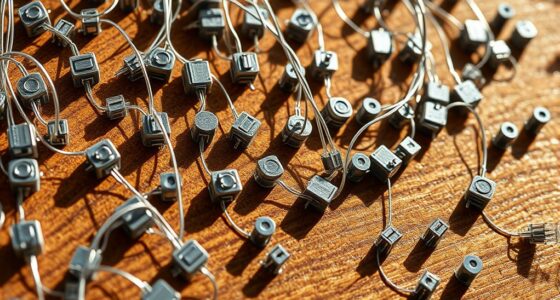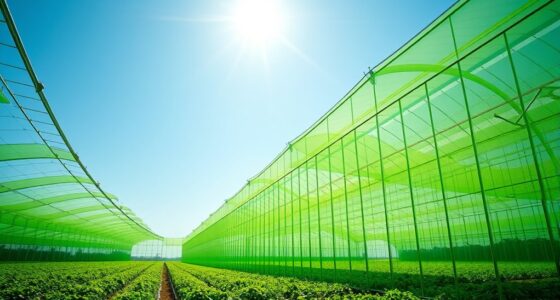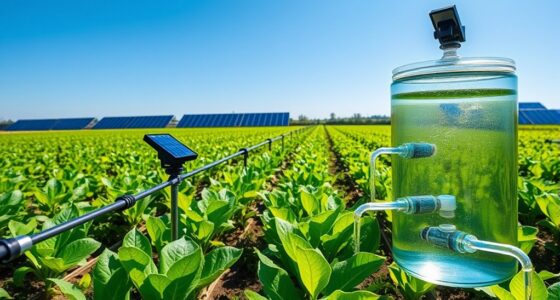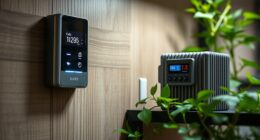Hydroponic systems like NFT, DWC, and aeroponics offer efficient ways to grow plants without soil, relying on nutrient-rich water and careful management. In NFT, you flow a thin nutrient film over roots; DWC immerses roots in oxygenated water, and aeroponics mists roots with nutrients. Each system requires regular checks of pH, nutrients, and cleanliness to guarantee plant health. Keep exploring for detailed tips to optimize your hydroponic setup and achieve better yields.
Key Takeaways
- NFT uses a thin nutrient film flowing over roots in sloped channels, requiring consistent flow and blockage prevention.
- DWC immerses roots directly in oxygenated nutrient water, needing oxygenation, temperature control, and regular cleaning.
- Aeroponics suspends roots in air, misting them with nutrients at scheduled intervals, demanding nozzle maintenance and pathogen control.
- All systems depend on proper nutrient balance, pH, EC, and system cleanliness for optimal plant growth.
- Regular monitoring and maintenance prevent clogs, algae, root rot, and ensure system efficiency across NFT, DWC, and Aeroponics.
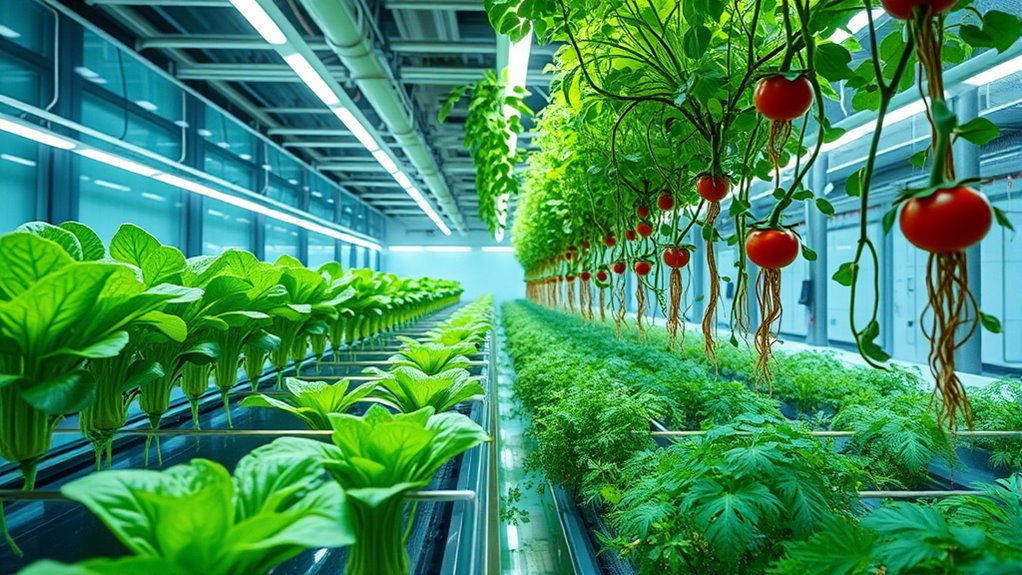
Have you ever wondered how plants can thrive without soil? It’s fascinating, really. In hydroponic systems, plants grow in nutrient-rich water solutions instead of traditional dirt. This method relies heavily on understanding plant nutrients—those essential elements like nitrogen, phosphorus, and potassium that plants need to grow healthy and strong. When you’re managing a hydroponic setup, maintaining the right balance of these nutrients is essential. If you get it wrong, your plants can show deficiencies or become susceptible to diseases. That’s why system maintenance becomes a key part of successful hydroponic gardening. Regularly checking and adjusting the nutrient solution ensures your plants get all they need for ideal growth. Additionally, understanding plant nutrient requirements helps optimize system performance and plant health.
In nutrient film technique (NFT), you set up a thin film of nutrient solution flowing over the roots of your plants, usually in a slightly sloped channel. Here, system maintenance involves ensuring the flow remains steady and free of blockages. You need to monitor the nutrient solution’s pH and electrical conductivity (EC) levels, because these influence nutrient availability. If the flow slows or stops, roots can dry out or become waterlogged, leading to plant stress or death. Keeping the channels clean and free from algae or debris is also essential, as it prevents clogs and promotes healthy root development. The continuous circulation of nutrients in NFT allows for quick adjustments, but it also demands regular checks to prevent imbalances.
Deep water culture (DWC) immerses plant roots directly into a nutrient-rich, oxygenated water reservoir. Maintenance here involves keeping the water oxygenated with air stones, and regularly replacing or adjusting the nutrient solution. If the water becomes stagnant or contaminated, roots can rot or develop disease. You’ll need to monitor water temperature, as warmer water holds less oxygen and encourages bacteria growth. Regularly testing and adjusting the nutrient concentration ensures your plants aren’t under- or over-supplied with essential nutrients. It’s also important to keep the container clean, preventing algae buildup that can compete with your plants for nutrients or clog the system.
Aeroponics suspends plant roots in the air while misting them with a nutrient solution at regular intervals. This system demands meticulous system maintenance—spray nozzles must stay unclogged, and the misting schedule needs to be precise. Since roots are exposed, they’re highly dependent on the consistent delivery of nutrients and oxygen. You’ll need to monitor the nutrient solution’s composition constantly, ensuring it remains balanced and free of pathogens. Any interruption or imbalance can quickly impact plant health. Regular cleaning of the nozzles and reservoir prevents mold, algae, and bacterial growth. Overall, system maintenance in aeroponics is about precision, ensuring that every spray delivers the right amount of nutrients at the right time.
In all hydroponic systems, proper management of plant nutrients and diligent system upkeep form the backbone of success. When you stay attentive to these factors, you create an environment where plants can flourish rapidly and efficiently, making hydroponic gardening an effective alternative to traditional soil cultivation.
Frequently Asked Questions
Which Hydroponic System Is Most Suitable for Beginners?
You’ll find DWC (Deep Water Culture) the most beginner-friendly setup because it’s simple to set up and maintain. It’s also a cost-effective option, making it perfect for newcomers. With DWC, you just need a container, air pump, and some net pots, so you can start growing quickly without complicated equipment. This system helps you learn the basics of hydroponics while keeping the process affordable and manageable.
How Do Nutrient Levels Vary Between NFT, DWC, and Aeroponics?
You’ll find nutrient levels in these systems dance to different tunes. NFT keeps nutrients at a gentle, steady pace—like a slow waltz—while DWC offers a more robust, consistent concentration, almost like a rock concert. Aeroponics, however, keeps nutrients in a fine mist, requiring tight control of pH fluctuations to prevent chaos. So, your nutrient concentration varies, demanding attention to pH shifts for healthy plants.
What Are the Common Pest Issues in Hydroponic Systems?
You’ll often face pests like aphids, spider mites, and fungus gnats in hydroponic systems. To manage pests effectively, practice pest management strategies such as regular inspection and introducing beneficial insects. Disease prevention is essential; keep your system clean, monitor humidity, and avoid overwatering to prevent mold and root rot. Staying vigilant helps protect your plants and guarantees a healthy, productive hydroponic setup.
How Do Hydroponic Systems Affect Plant Taste and Quality?
Hydroponic systems can enhance your plants’ flavor and quality by providing precise nutrient delivery, boosting nutrient density. This controlled environment allows you to optimize conditions, resulting in richer flavors and better overall taste. Additionally, you can experiment with flavor enhancement techniques by adjusting nutrient solutions, leading to healthier, more vibrant plants. As a result, your harvests are more flavorful, higher in nutrients, and of superior quality compared to soil-grown counterparts.
What Are the Environmental Impacts of Hydroponic Farming?
Think of hydroponic farming as a green oasis in a desert of environmental impact. It markedly reduces your carbon footprint by using less land and energy. Water conservation is a key benefit, as it reuses and recycles water efficiently. However, energy use for artificial lighting and climate control can add up. Overall, it’s a more sustainable choice, helping you grow healthy produce while minimizing environmental harm.
Conclusion
Now that you know about NFT, DWC, and aeroponics, you’re ready to delve into hydroponics like a true pioneer, even if it’s not as glamorous as a space station. Each system has its perks, so pick one that suits your style and space. Remember, with a little patience and a splash of curiosity, you’ll be growing fresh, healthy plants in no time—no need for a time machine, just a green thumb!



